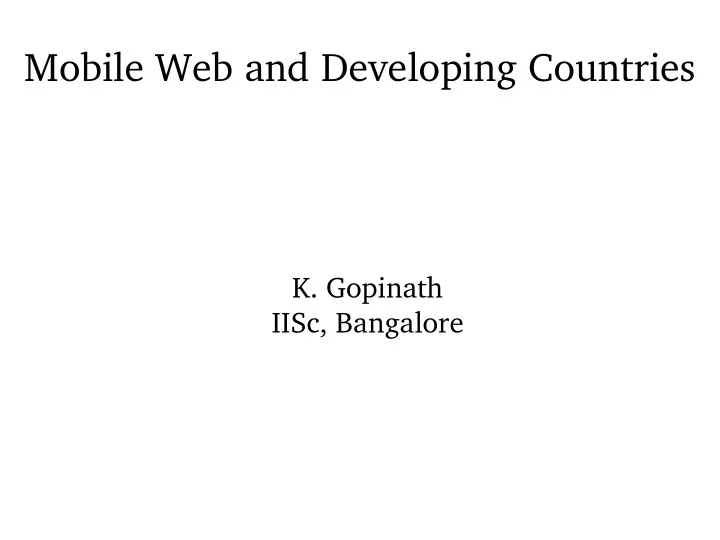

Mobile Web and Developing Countries K. Gopinath IISc, Bangalore
Drivers for a Mobile Web in India ● Cost! – PC cost a limiting factor in Internet's spread ● Linguistic Reasons – Current Internet dominated by “English” and “structured prose” – Mobile Web requires less “prose” but more quick and direct interactions ● “Hinglish”/Ideograms ● Social and Environmental Reasons – Need an extremely simple but effective coord device
Cost ● Rs 20K (approx) reqd for a PC is still about the avg annual income in India – Even if bought on a loan, requires Rs 150pm interest alone on the loan – Since it is unaffordable except the “rich”, many services for the “not so rich” not just avlbl in the Indian Internet ● Eg: bus schedules in Bangalore not on net as of last year – Usefulness of Internet to general population is a ? – A PC-based Internet also not very useful as most of the population does not have a “white-collar” job ● Service sector requires mobility; a mobile Web a closer fit to what is reqd (also explains why voice mobile uptake very strong) ● Need a device close to Rs 1000-2000: only a mobile is in this range. Price of a cycle (Rs 2000) “semi-affordable”
Linguistic Aspects ● “English” infrastructure appropriate only to the top 5% of the population in India – Voice mobile more prevalent in small towns than Internet ● “Hinglish” ( Hin di+Eng lish ) etc can take root if less attention paid to “literary” style, etc ● A “sign” based lang more appropriate? – Pidgin and Creole resulted historically when a dominant language used in interactions with a dominated population – Currently, use of English in that category for the 90% pop. ● Font issues are big wrt Indian langs! – Need standardised ways of interoperability between “legacy” fonts
A good “coordination” device? ● Need “collective” wisdom to solve pressing probs such as TB, env. degradation, water pollution, AIDS,... – Success of efforts such as Wikipedia, social tagging are examples of how “small efforts” can be pooled – India has been doing this for many years also! ● Coops (milk, clothing, ...) ● “SHG”s ● Mumbai “dabbawalas”? ● “Pani panchayats” – Need to provide a coord device that bootstraps solutions for “big” problems not (yet satisfactorily) solved ● At the same time, environmentally less demanding – Less load compared to PCs or older models (eg newspaper)
Environmental Impact of News Delivery ● Preliminary analysis (details in paper): Paper route better than thru PC+Web! – On newspaper ( life cycle analysis ): 3.2Wh per A4 page – On a PC almost double (6.7Wh) – On a mobile (very inconvenient right now!): 0.2Wh ● If a good number of people in a city use a PC at the same time, the electric grid may not be able to handle it (esp in Indian cities...)
Two Approaches for Delivering Content ● Make content simpler somehow so that the form factor of the mobile can handle it – Transcoding, remove “clutter”, data/voice integration for effective use of “actionable” data – However, non-English languages (such as Hindi, Telugu, ...) have a more complex aspect (input, fonts, search, ...) – Requires “intermediate” processing ● May be non-standard and may become interoperable – Cannot make things simpler!? i18n more complex than ASCII! – Any customization involves managing the device (“sysadm”) ● Not possible with “naive” users ● Keep mobile web experience same as on the PC – Is it possible? May be?!?
● One solution: make the mobile a “modem” – Use of voice and data “disjoint” functions ● I have used a CDMA 1xRTT phone that way... A Proposal – Need addl devices for display, etc. ● Or, make the mobile a platform a good “appl modem” ● instead of just transmitting bits – Make it a “low” mgmt platform: A “thin” mobile! – Have ability only to display (graphics/video) data from server (resized for form factor) with all processing on servers (incl fonts, etc...), and have the ability to connect to std displays/keyboard/TV. [Use some form of “Display Postscript”/SVG Tiny] – Much more easy to make it a “secure” platform ● Only need to guarantee the “thin” mobile model and its sw – May be less prone to obsolescence?
A Mobile = Effective “PC”? ● With newer addons to mobiles, can be “equal” to a PC (at a much lower cost?) – Virtual “laser” keyboard and (?) “nano-projectors” – Head-mounted displays and “virtual reality env” – Newer types of “flexible” displays ● Once Mobile Web bootstrapped, can possibly later move to a “full” Internet once input/output problems with mobile solved using the above kind of technologies
Mobiles and “Public GIS” ● GIS-based analyses needed widescale ● However, good GIS sw typ proprietary and no economies of scale ● Need a “public GIS” – SVG-based GIS on mobile? – Mobile web the input device & possibly also output device – Report geo-located info (weather, medical emergencies, env pollution, biodiversity cataloging, epidemological observations, disaster mitigation, ...) – May be an imp component in getting a handle on “big” probs
Enable new modes of societal interaction? ● If micropayments or “easy” (micro)coordination feasible, may enable new modes of societal interaction crucial for longterm sustainability? – eg. carpooling, groundwater use, – “Free rider” problem needs to be solved ● An “authenticated” mobile can be a part of a solution if sufficient care is taken to preserve privacy at the same time ● Currently, not possible – Either sub-optimal solutions or (worse) tragedy of the commons
Conclusions ● Mobile Web a singular opportunity for developing countries such as India ● A “low mgmt” and secure platform critical – security and privacy needs attention ● However, from an appl perspective, unclear what direction to follow as of now given the “English” domination and the non-presence (“invisibility”) of the non-English majority
Recommend
More recommend